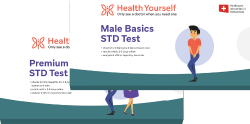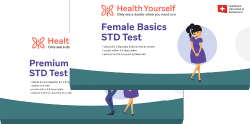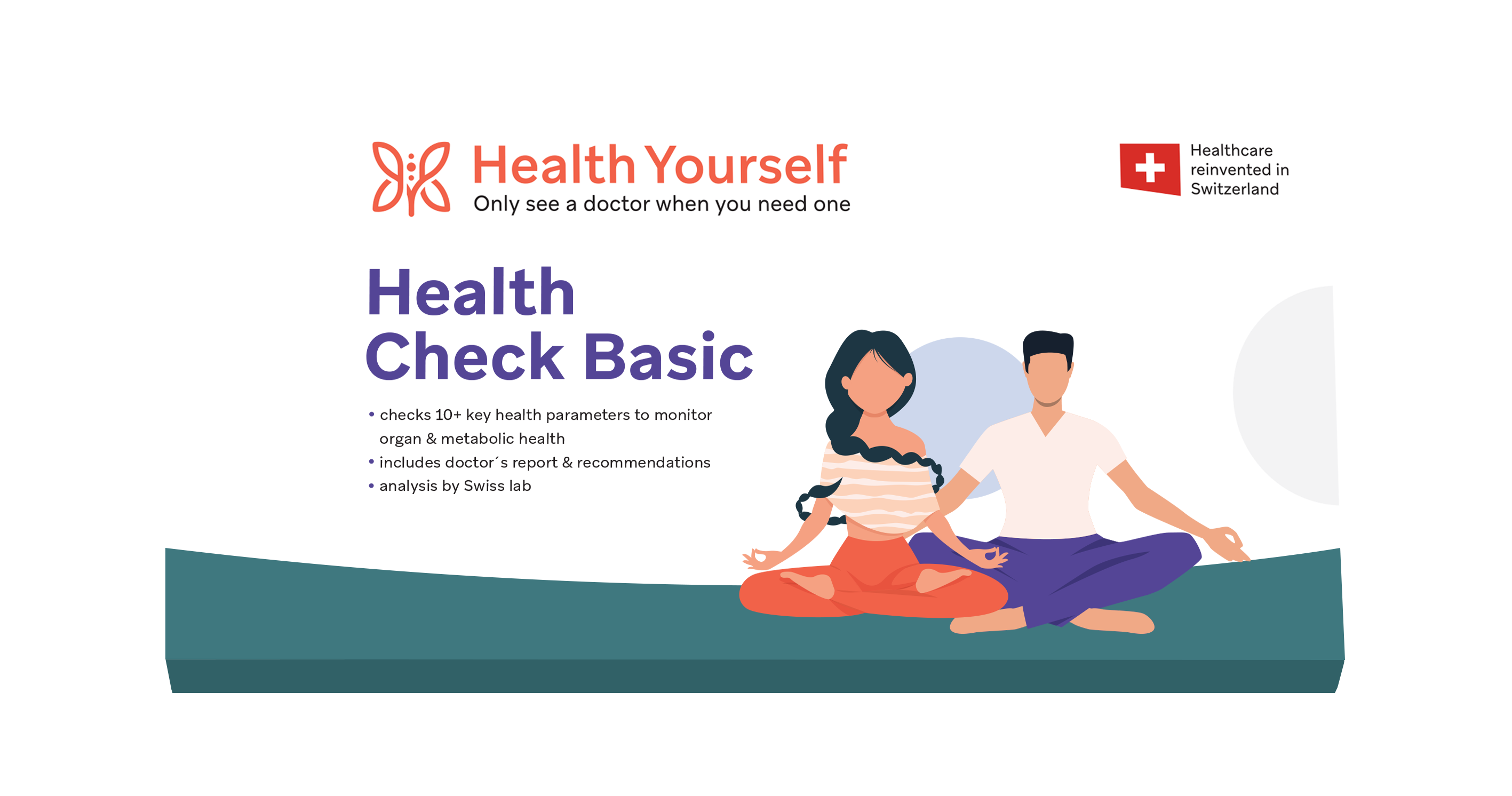Entire test process works from the comfort of your own home. No doctor's visit needed.
Delivery in a discrete envelope or parcel withou any labeling. Take your sample from the privacy of your home.
Analysis by leading Swiss laboratory Medisyn (formerly known as Synlab). Application of the same analysis method as for a sample from a doctor's office.
Results online within 2-3 working days.
You generally save 20-30% compared to testing at a doctor's office.
New relationship? Or changing sexual partners? Then testing regularly will give you peace of mind and also protect your and your partners health.
New relationship? Or changing sexual partners? Then testing regularly will give you peace of mind and also protect your and your partners health.
Test parameters
1. Human immunodeficiency virus, or HIV, is a virus that attacks cells with are part of the body’s immune system. It thus infiltrates the immune defenses and cannot be eliminated.
2. While there’s no cure for HIV yet, effective HIV treatment, known as antiretroviral therapy, can reduce the amount of virus to undetectable levels, allow people to live a normal life and prevents the virus' transmission to others.
3. It is possible to get infected with HIV and not know it. According to CDC in the US one in seven people currently infected do not know they are.
HIV typically runs in 3 stages:
Stage 1: Acute HIV Infection
About two-thirds of people will develop symptoms that feel like a really bad flu during the first two to four weeks after infection, the rest might don't get any symptoms at all. Fever may develop along with additional symptoms, such as sore throat, swollen glands, mouth sores, rashes, diarrhea, fatigue, headache, and muscle and joint pain.
Stage 2: Clinical Latency
Without diagnosis or treatment the immune system can bring the virus level down some, but it can’t completely control or eliminate it. The virus is still active but multiplies more slowly, often without causing any symptoms. This stage can last up to 15 years. At this stage, people with HIV who aren’t taking medication still have a sufficient amount of virus in their system to transmit it to others, even if they don’t have symptoms, and the virus continues to damage the immune system over that time, leading to worsening health.
Stage 3: Acquired immunodeficiency syndrom (AIDS)
The immune system is so severely weakened that other infections - so called opportunistic infections -, which can be easily fought in healthy individuals, spread through the body. These include pneumonia, fungal infections, and virus-induced cancers. Additionally, people with AIDS frequently have systemic symptoms such as prolonged fevers, sweats (particularly at night), swollen lymph nodes, chills, weakness, and unintended weight loss.
According to an estimate by the Joint United Nations Programme on HIV/AIDS (UNAIDS), there are currently roughly 37 million (range between 34 and 41 million) people living with HIV or AIDS worldwide. According to recent estimates, around 16'600 HIV-infected people live in Switzerland. In 2020, 290 new HIV diagnoses were made, the trend is decreasing since 2008.
According to Swiss Federal Office of Health the majority of reported HIV cases concerns men (about 79%) . Sex with other men was cited as the most common route of infection (50.8%). This was followed by heterosexual contacts (26.5%). The use of contaminated injectables for intravenous drug use (IDU) was found in 2.2%. Women diagnosed with HIV in 2020 mainly contracted the infection through heterosexual routes (69.6 %), similar to previous years. 93% of all persons living in Switzerland with HIV in 2020 have a corresponding diagnosis and thus knew of their infection.
After a risk situation, such as unprotected vaginal or anal intercourse (especially in a region with a high number of infected people) or at the start of a new relationship, having an HIV test is a good option as it provides clarity and safety.
Without diagnosis and treatment, HIV leads to increasingly severe immunodeficiency and eventually serious secondary infections or cancer. The body is not able to control or eliminate an HIV infection. Without adequate therapy, HIV infection inevitably leads to death.
A variety of HIV medications are available. All of them aim to reduce the virus load in the body as much as possible, so that symptoms disappear and there is no danger of passing on the virus. For an adequate therapy, a combination of different drugs is necessary, which is known as "HIV combination therapy". This combination therapy is a lifelong treatment. A complete cure is unfortunately not yet possible.
1. Syphilis is a bacterial infection that's typically spread through sexual contact.
2. The first sign of syphilis is most commonly a painless sore, called a chancre, that develops where the bacteria entered the body.
3. After the initial infection the bacteria can lie dormant in the body for years before becoming active again. With no visible symptoms, the only way to know that you have syphilis is to be tested for it.
Syphilis can present in one of four different stages and max also occur congentially:
Primary
Approximately 2-6 weeks after sexual contact a skin lesion, which is called a chancre, develops at the side of contact. There may be single or multiple sores, which are usually firm, round, and painless and can often go unnoticed. The sore(s) typically last three to six weeks with or without treatment.
Secondary
Secondary syphilis occurs approximately four to ten weeks after the primary infection. While it is known for the many different ways it can manifest, symptoms most commonly involve the skin, which manifest itself in a rough rash with red or reddish-brown spots. Other symptoms include fever, sore thorat, sores in mouth, vagina or anus, muscle aches, fatigue etc.
Latent
If syphilis goes untreated, it moves from the secondary stage to the latent or hidden phase, where there are no symptoms. This stage is defined by a serologic proof of infection without symptoms of disease. This stage can last for years, and the signs and symptoms may never come back or the disease can progress to the third, or tertiary stage.
Tertiary
Approximately 15 to 30 percent of people infected with syphilis who don’t get treatment will develop late or tertiary syphilis. It may be divided in gummatous syphilis, which is characterized by formation of soft tumor-like balls of ski, bone and liver, late neurosyphilis, which is an infection of the central nervous system with most often severe complications, and cardiovascular syphilis. People with tertiary syphilis are not infectious.
Congenitally
Syphilis can be transmitted during pregnancy or during birth. Two-thirds of syphilitic infants are born without symptoms. Symptoms, which can develope are enlargement of liver and splen, rash, fever, infection of the nervous system and lung inflammation.
Long term health risks include infection of the nervous system with neurologic impairment even at an early stage and development of a tertiary syphilis with severe complications such as serious neurologic damage, cardiovascular problems or disfiguring skin changes.
The number of syphilis cases is increasing again worldwide, principally in highly developed countries, including Switzerland. An increased risk of infection exists mainly for men who have sex with men, for persons with numerous different sexual partners and in the context of prostitution. Since 2010, more than 400 persons in Switzerland have contracted syphilis each year, more than 80% of whom are men.
Condoms reduce the risk of getting infected with syphilis. But an infection is possible despite condom use. It is important to detect and treat an infection early. Therefore, regular testing before entering a new relationship or in risk constellations such as frequently changing sexual partners (especially men with men) is useful and recommended.
Syphilis is easy to treat in early stages and can often be cured with just one injection of antibiotic. It just has to be diagnosed by proper testing.
1. Hepatitis B is an infection of the liver that is caused by the hepatitis B virus (HBV). An infection may be either acute (self-limiting) without any long-term consequences or chronic (long-standing) with severe impairment of the quality of life.
2. Sexual intercourse and intravenous drug use are the most frequent routes of infection in westerly countries.
3. An available vaccination reliably protects against infection.
The acute infection begins with general ill-health, loss of appetite, nausea, vomiting, body aches, mild fever, and dark urine. It progresses to development of jaundice. The illness lasts for a few weeks and then gradually improves in most affected people. The infection may be entirely asymptomatic and may go unrecognized but also severe courses with liver failure have been described.
In older adolescents and adults, chronicity of the disease occurs in about 3-5%. A chronic inflammation may lead to cirrhosis over a period of several years. This type of infection dramatically increases the incidence of liver cancer (hepatocellular carcinoma). Other associated long-term consequences are kidney diseases (membranous glomerulonephritis) or polyarthritis.
According to Federal Office of Health in Switzerland, about 0.5% of the population are infected with the hepatitis B virus, while worldwide figures average around 3.5 %. Around 40 cases of acute hepatitis B are notified per year in Switzerland, with a downward trend. Men are much more affected by acute hepatitis B; they make up about 75% of cases. The age group 35-60 years makes up the majority of cases (roughly 55%).
Acute hepatitis B infection does not usually require treatment and most adults clear the infection spontaneously. Antiviral treatment is available for severe cases and for chronic infection to reduce the risk of cirrhosis and liver cancer.
1. Hepatitis C is an infectious disease caused by the hepatitis C virus (HCV) that primarily affects the liver. The virus persists in the liver in about 75% to 85% of those initially infected. Over many years it often leads to liver disease and cirrhosis.
2. Only about 20 to 30 percent of people with hepatitis C will develop signs and symptoms of the virus soon after being infected. Some people learn of it only after years when developing severe health issues.
3. There’s currently no vaccine that can prevent hepatitis C.
About 70 to 80 percent of people who become infected with acute hepatitis C do not show any symptoms at first. When symptoms appear it usually happens 4-12 weeks after infection. Symptoms are generally mild and vague, and may include fatigue, nausea and vomiting, fever, muscle or joint pains, abdominal pain, decreased appetite and weight loss. Jaundice, dark urine, and clay-coloured stools may also occur.
About 80% of those exposed to the virus develop a chronic infection over several years. Chronic hepatitis C can be associated with fatigue and mild cognitive symptoms and may lead to cirrhosis and liver cancer.
Because of the lack of symptoms, only testing after risk contact will bring clarity.
Without proper treatment 75 to 85 percent of people with hepatitis C develop a chronic infection, which can last a lifetime. Chronic hepatitis C can lead to hepatitis C–related complications, including chronic liver disease, cirrhosis, and liver cancer.
According to Federal Office of Health in Switzerland, about 0.5 % of the population are infected with the hepatitis C virus, while worldwide figures average around 1 %. The number of people reported with acute hepatitis C has remained stable in Switzerland since 2006; about 50 new cases are reported each year. The share of men is consistently high, amounting to around 70 %; young adults 20 to 39 years old are also affected to a significant degree (about 60 to 65 % of cases). The majority of newly diagnosed infections can be traced back to intravenous drug use, but there is a non-negligible number of transmissions through sexual intercourse.
Because of the lack of symptoms, only testing after risk contact will bring clarity.
A variety of well-performing antiviral medications are available for the treatment of hepatitis C. Various combinations are available depending on the individual course of the disease.
More than 90% of people with chronic infection can be cured when treated with medications.
How the test works
01
Order your test kit
Orders before 16:00 on a working day are shipped the same day and usually arrive the next working day with Swiss Post.
02
Take your sample from home
The test kit will contain all the necessary material for you to collect a small blood sample from your finger. Never done that before? Don't worry, detailed video instructions are provided and thousands of customers have used them to successfully take their sample.
03
Send your sample to the lab for analysis
Next, you put your sample into the provided Retourbox and drop it off in a Swiss Post mailbox. It will be analysed by our Swiss laboratory partner, Medisyn (formerly known as Synlab).
04
Receive your results online
Your results will be available online 2-3 working days after sending your sample to the lab.
Your test results & official lab report will be available online after 2-3 working days.
Your test results & official lab report will be available online after 2-3 working days.
Cost comparison doctor's visit
How much do I pay compared to a doctor's office?
Please note: All values are rounded and estimated based on relevant Tarmed positions, individual charging decisions by doctors can lead to deviations.
Cost components at the doctor's office*
Consultation with preparatory discussion of diagnostic service
CHF 70
Sampling
CHF 7
Lab analysis
CHF 134
Discussion of results
CHF 50
Total cost
CHF 261
Cost with Health Yourself
All-in price
CHF 199
Total cost
CHF 199
Please note: All values are rounded and estimated based on relevant Tarmed positions, individual charging decisions by doctors can lead to deviations.
All analyses included in this test are also offered through doctors' offices or sexual health centers by our laboratory partner Medisyn (formerly known as Synlab). You effectively receive the same test, only the sample collection method differs.
Medisyn is the largest provider of laboratory services in Switzerland and uses state-of-the-art technology for analysis of all samples.
Questions about this test? We have answers.
How quickly will I receive my test?
From Monday to Friday, all orders submitted before 16:00 are shipped on the same day and will usually arrive on the next working day including Saturday. All tests ordered over the weekend are shipped on Monday and usually arrive on Tuesday.
How will my test be delivered?
All tests are delivered by Swiss Post in discrete enevolpes or parcels without any outside markings.
Will I be able to take my sample correctly without any medical training?
You do not require any medical training to use our tests. We provide very detailed instructions on how to take your sample and several thousand customers have already successfully taken their tests.
How do I return my sample to the lab for analysis?
You simply put your sample into the return box we provide with each test kit and drop the return box off in any Swiss Post mailbox. You do not need to add a stamp, this is already printed on the return box.
Who analyses my sample?
Your sample is analysed by our laboratory partner Medisyn (formerly known as Synlab). Medisyn is one of the largest laboratory service providers in Switzerland. You might have encountered them during COVID.
Are the results as reliable as from a doctor's office?
All analyses included in this test are also offered through doctors' offices or sexual health centers by our laboratory partner Medisyn (formerly known as Synlab). You effectively receive the same test, you only collect the sample from home instead of at the doctor's office.
Medisyn is the largest provider of laboratory services in Switzerland and uses state-of-the-art technology for analysis of all samples.
How long does it take to receive my results?
Your results are generally available online 2-3 working days after you have sent your sample to the lab for analysis.
Will I be able to understand my results without any medical training?
All tests results are easily understandable without any medical training and include clear explanations.
What if I test positive for an STD?
If you test positive, your test results will include clear guidelines on what to do next. As part of your results, you will also receive an official laboratory report from our accredited laboratory partner. Accordingly, laboratory reports are recognized by physicians in Switzerland and can serve as a basis for treatment. Soon, you will also be able to immediately access treatment through our platform, no doctor's visit needed.
Related products





